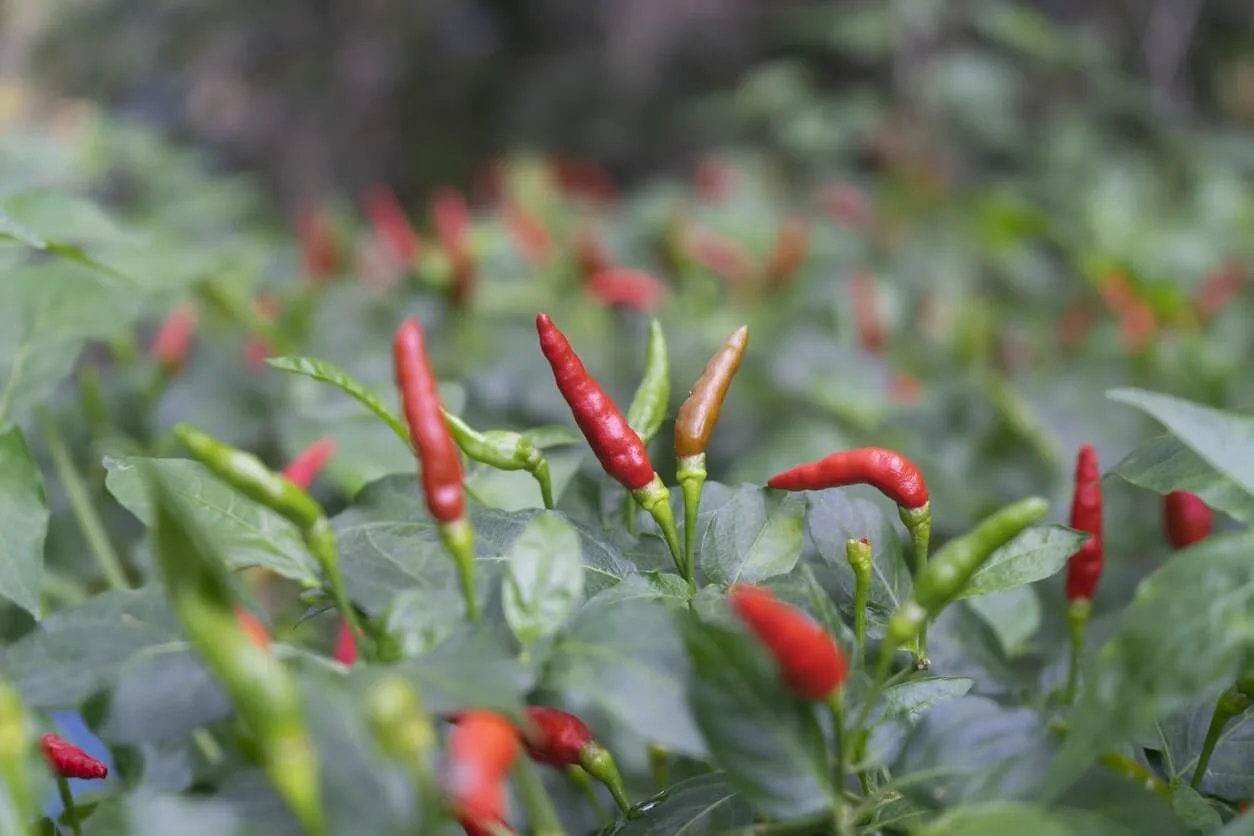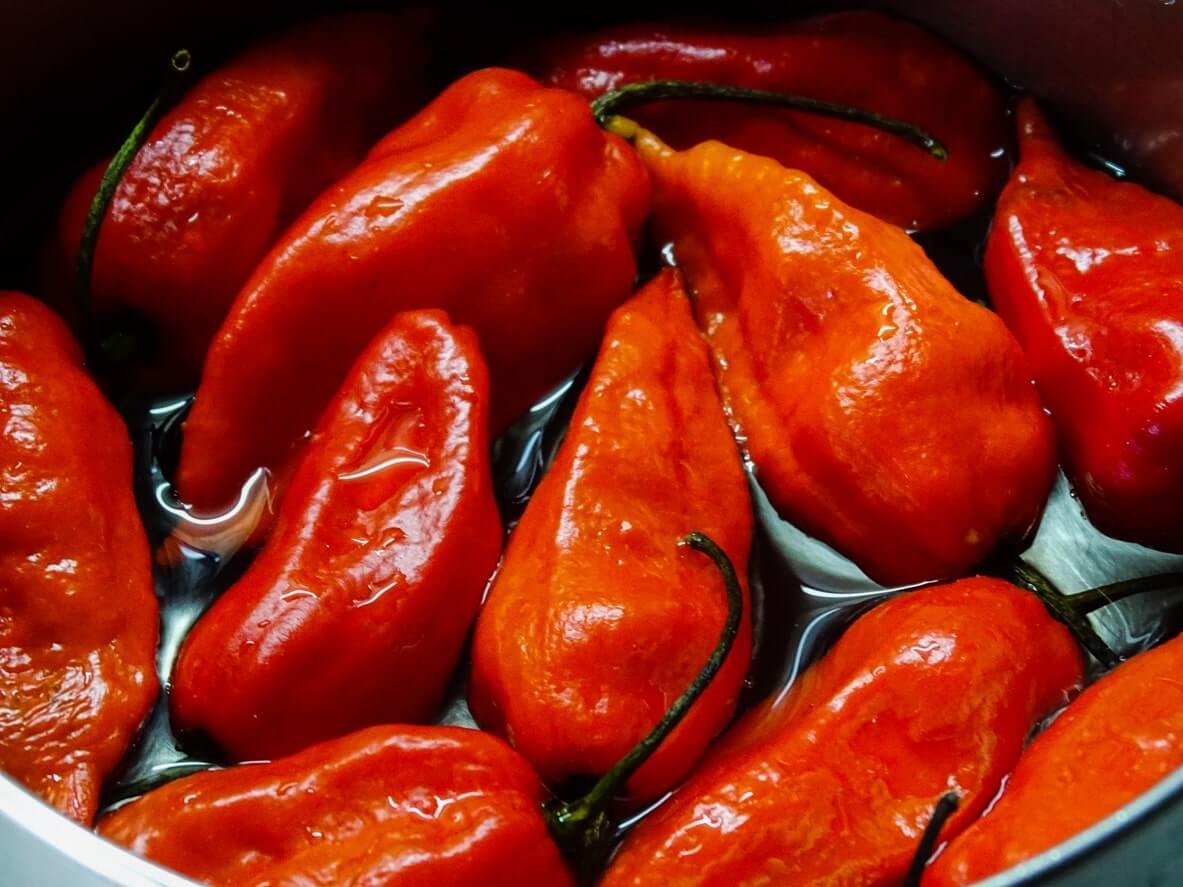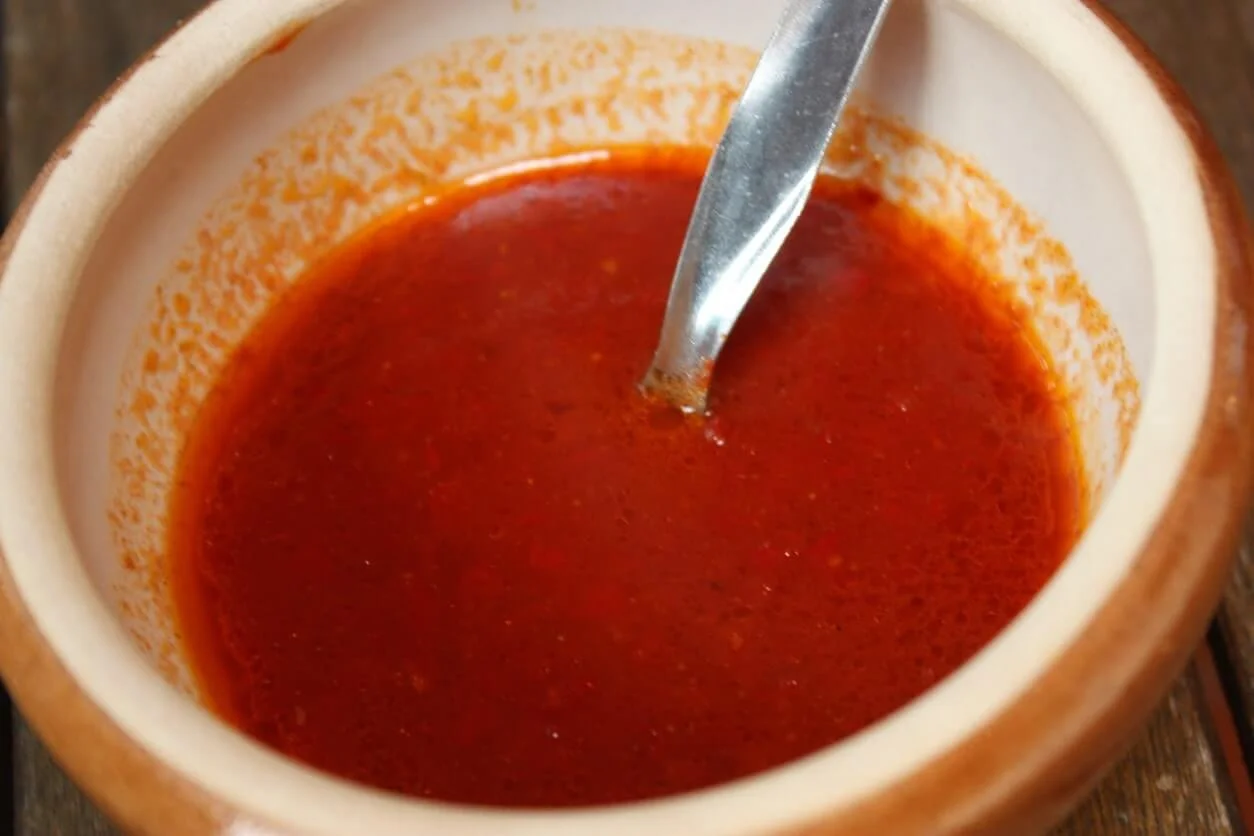How To Ferment Peppers & Turn Them Into Hot Sauce
Discover > Texas Home Cooking > Fermenting > How To Ferment Peppers & Turn Them Into Hot Sauce
Whether or not you're a fan of spicy foods, (What wine goes well with spicy food?) hot sauce (how long does hot sauce last?) is one of the pillars of Tex-Mex cuisine, and whether you're looking for a spicy death or some sweet heat, there's undoubtedly a hot sauce out there for you.
But what better way to explore the world of pepper sauces than making your very own? If you're asking how to ferment peppers to make hot sauce? It's not complicated; at its most basic, it's just a combination of fermented peppers and vinegar.
The sky is the limit as to what type of hot sauce you can create with peppers. From choosing the right pepper to suit your taste to adding extra ingredients for flavorings like garlic, honey, fruit, herbs, and spices, the possibilities are endless!
So take your burgers, pizza, steak, pork, chicken, beef, or veggie dishes to the next level by brightening them up with some homemade hot sauce!
Alright, let's get down to the nitty-gritty of how to make fermented hot sauce. I mean, who doesn't want to boast about their homemade condiment, right?
Making your fermented hot sauces is like a rite of passage in the world of fermented vegetables. Whether you're a fan of jalapenos, scotch bonnets, or good old banana peppers, there's a fermented hot sauce recipe out there with your name on it.
Fermented peppers take your hot sauce game to a whole new level. Not just in terms of heat, but with a depth of flavor that only fermentation can bring. It's the secret weapon in any fermented sauce – that tang, that zing, that je ne sais quoi that takes your cooking to new heights.
So, ready to dive into the world of fermented hot sauce recipes? Stick around as we turn up the heat on how to ferment peppers and turn them into hot sauce. It's going to be a delicious ride!
How to Ferment Hot Peppers for Hot Sauce?
Fermentation is a process that can change the flavor of food and make it more nutritious. It's also a process that requires a little bit of patience, but it's worth it if you want to make your hot sauce.
There are two different types of fermentation, which are called anaerobic and aerobic. An anaerobic fermentation takes place in an airtight container whereas an aerobic fermentation takes place in an open container with room for oxygen to flow freely into it. Fermenting peppers is typically done with anaerobic fermentation because it helps create a more stable product with less chance of contamination from other microorganisms.
Now, while we could certainly go on all day about the science behind the process of fermenting peppers for hot sauces, here are the basics that you have to know:
Ethanol Fermentation
Ethanol Fermentation involves yeast (and some strains of bacteria) to convert a glucose molecule into 2 molecules of pyruvate, then into acetaldehyde (the chemical that causes hangovers and time/memory lapses after a night on the town), and finally into ethanol within a base depending on what fermented foods (What wine goes well with fermented foods?) you’re making (sugar in the case of rum, barley (how long does barley last?) for whiskey, etc.)
Lactic Acid Fermentation
Lactic Acid Fermentation (which is the one we’re using in this recipe) uses microorganisms like bacteria or fungi to convert sugar (glucose) into lactic acid to obtain energy. Carbon dioxide is a by-product of any form of fermentation. During the fermentation, glucose is converted into 2 molecules of pyruvate, the pyruvate is converted into lactate via an enzyme called lactate dehydrogenase, which as a result produces CO2 and lactic acid.
How to Ferment Hot Peppers for Hot Sauce by Adding Salt?
Thus far it seems that all you need to ferment a vegetable is said vegetable and some water, which is technically true be it one of the worst ways to ferment anything. Adding a high concentration of salt goes a lot farther than just impacting flavor. Forget about low-sodium options, to make a great sauce, you must have complex flavor in it. Plus, you're not going to be slathering your dishes with hot sauce the same way you would with ketchup, a few drops will go a long way!
Salt doesn’t just keep your veggies fresh in terms of color and texture, it also prevents any unwanted bacteria from propagating into their colonies. Lactic acid bacteria have a much higher tolerance for salt than most other bacteria and therefore can keep fermenting the glucose even in high salt concentration levels. Salt does however slow that process, which is a great thing because it gives time for those funky flavors to come through.
Choosing The Best Peppers for Hot Sauce
In making hot sauce, it should be abundantly clear that the pepper you use should focus on how spicy you like it to be. Although, some people can add fillers, such as bell peppers and green peppers, to add a bit of sweetness to their mix.
For pickling Carolina Reapers they are one of the hottest peppers in the South, and it’s safe to say that if you’re a fan of the milder sauces, you shouldn’t use something with a Scoville rating of over two million. All peppers produce a chemical called capsaicin. The stress under which the pepper is grown determines how much capsaicin it produces, determining how hot said pepper is.
The following is a list of hot peppers from mild to most scorching. There are at least a couple hundred different peppers you can choose from for your hot sauce, all with a different flavor and level of spice. Also, take color into account. Fresh peppers can be white, red, green, orange, yellow, purple, or even black. You can make some great color pallets with those.
The intensity of a pepper is measured by the number of times capsaicin needs to be diluted by sugar water. The measurement is called the Scoville scale and the unit for the measurement is the Scoville heat unit (SHU).
Green
Banana Peppers 0 – 500 SHU
Cajun Belle 100 – 1000 SHU
Ancho 1000 – 1500 SHU
Chipotle 2500 – 8000 SHU
Jalapeno Peppers 2500 – 8000 SHU
Mild
Peter pepper 5000 – 30000 SHU
Serrano peppers 10000 – 25000 SHU
Black Pearl 10000 – 30000 SHU
Tabasco peppers 30000 – 50000 SHU
Cayenne peppers 30000 -50000 SHU
Spicy
Super chili peppers 40000 – 50000 SHU
Pequim 40000 – 80000 SHU
Charleston hot 70000 – 100000 SHU
Apache 80000 – 100000 SHU
Hot
Devil’s Tongue 125000 – 325000 SHU
Goat peppers 100000 – 350000 SHU
Scotch Bonnet 100000 – 350000 SHU
Habanero 100000 – 600000 SHU
Scorching
Ghost peppers 800,000 – 1,050,000 SHU
Infinity peppers 1,060,000 – 1,250,000 SHU
Caroline reaper 1,400,000 – 2,200,000 SHU
Dragons breath 2,500,000 SHU
Fermentation Brine
The basis of a fermentation brine is just salt and purified water. Unless you’re storing the ferments for a prolonged period, you can just use tap water (some people like to boil it first) since the salt will prevent any unwanted bacteria from growing within a short period. The brine percentage for hot sauce and the amount of salt you use depends on the amount of water, the type of salt you use, and the vegetable you’re fermenting.
The softer the vegetables are, the more salt you should add. There are many brine methods that you can do but a classic brine starts at a 2% salt concentration but can go up to 5 or 6 or 7% for much a softer result. In fermented cayenne pepper sauce, I recommend a 3-4% salt concentration. So for every cup of water (250 g/ml) use between 7.5 and 10 grams of salt.
You can pretty much use any edible salt to ferment, sea salt (how long does sea salt last?), kosher salt, (how long does kosher salt last?) pink salt, pickling salt, etc. Different salts have different structures and weights so use a scale over any spoon to measure the salt.
How Long Should I Ferment Peppers for Hot Sauce?
Once you’ve chosen your peppers all you need to do is cut the stems off the peppers and then halve them lengthwise. Don’t bother chopping them into small pieces; it’s a waste of time and just makes more of a mess.
Dissolve the salt in the water, stuff the pepper halves in a sealed container then top with the fermentation brine. Preferably, you should use a fermentation jar or any airlocked container for this but you can also use a mason jar as long as it can be sealed. Moreover, if you don’t have a jar with an airlock or a fermentation lid, make sure you use something like a fermentation weight or small ramekin to keep the peppers submerged. One of the most important steps to fermentation is making sure the peppers are fully submerged.
Leave the jar of peppers somewhere that’s around room temperature (between 64°F – 71°F is ideal) for at least a week or up to two weeks. Sunlight will interfere with the fermentation process so ideally keep the jar in a cupboard or pantry.
A couple of things will happen to your brine after it’s been fermenting for a couple of days. Firstly the water will become cloudy, which is normal and preventable if you use pickling salt. If you don’t have pickling salt and don’t feel like buying it don’t worry, it’s perfectly harmless.
You may also notice that a white residue will form on the surface of the water. This is called Kahm yeast and is also totally harmless. It’s not the same as mold (keep in mind that mold is fuzzy) and you can keep it from growing by fermenting the peppers at slightly below room temperature.
How to Make The Hot Sauce?
Once your peppers have fermented, strain them (but keep the brine), then transfer the peppers to a blender or food processor with a couple of tablespoons of neutral oil, an equal amount of vinegar, a couple of tablespoons of the brine, then pulse the pepper mash into a liquid state. If you prefer thin hot sauce, adjust the ratio as needed.
That is the very basic hot sauce recipe, and it’s where things can get interesting. This is where you can add practically anything you want. Fresh herbs and spices of your choice are a great option. Make sure you toast and grind your spices before adding them to the blended sauce and make sure all the herbs are fresh.
You can take things a lot further than just herbs and spices. Toasting fresh garlic in the oil you use is a phenomenal way to boost the flavor. You can use sugar, honey, syrup, or molasses (how long does molasses last?) for some sweetness, you can char and add fruits like pineapple, mango, apples, or berries, and one of my personal favorites is adding bacon drippings. You can also add some lime juice or lemon juice for that added brightness. I mean, the options are endless. For an extra smooth sauce, strain the finished hot sauce through a mesh strainer then bottle it (preferably in glass) and store it in the fridge for up to 90 days.
And the best part? You know exactly what goes into your homemade hot sauce! You can keep track of allergens and all of the ingredients.
So there you have it. Forget about grabbing a bottle of Frank's red hot from the shelf! Making fermented hot sauce consists of mostly just waiting with a bit of measuring and a bit of blending before and after. Make it as simple or as complicated as you want it to be and don’t forget to share it with the family, it’s the best part of being passionate about preparing food.
P.S. You've never had a proper bloody mary if you haven't tried it with some homemade fermented hot sauce! The depth of flavor is just amazing. Plus, you'll know exactly what flavors are packed in!
Ingredients
hot peppers of your choice
apple cider vinegar (how long does apple cider vinegar last?) or white distilled vinegar
Instructions
Prep the peppers by cutting the stems off them and halving them lengthwise. Remove seeds from the peppers then pile the halved peppers into a big, airlocked glass jar with a fermenting lid.
Make the brine by dissolving the salt in the water then pour the salt brine over the peppers.
Make sure the halved peppers are all fully submerged in the brine before closing the lid and labeling the jar with the date.
Place the jar somewhere dark between 64°F - 72°F for one to two weeks relatively undisturbed to let the peppers ferment.
After the peppers have fermented to your liking strain them (reserve the brine) then empty them into a blender with the oil, vinegar, salt brine, and anything else you want to add.
Pulse the ingredients until smooth then pour the pepper mash through a mesh strainer for an extra smooth sauce.
Bottle and store the hot sauce in the fridge for up to 90 days and enjoy whenever the mood strikes.
Now that you know the process of fermenting peppers to make hot sauce, it’s now time for you to shop for the ingredients.
If you've ever been curious about ghost towns, it's time to pack your bags for a trip down the road. Check out these eight Texas ghost towns that are surprisingly not so scary.





